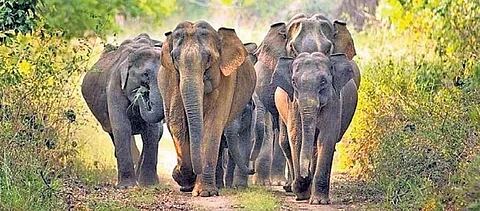

CHHATTISGARH: The traditional radio may be losing its sheen. However, in the regions of Chhattisgarh where people live in fear of wild animals, the radio plays a crucial role in averting tragedies, particularly by forewarning residents about the movement of elephants.
Chhattisgarh has registered innumerable incidents of destruction and threats to life and property due to unexpected and uninterrupted elephant rampages.
To counter the menace, as a first-of-its-kind in the country, an initiative has been undertaken; ‘Hathi Samachar’.
As one may rightly guess, it refers to a news broadcast on wild elephants: a programme that informs its audience on specific locations and movement of wild pachyderms.
Launched in 2017, the programme has emerged as a popular medium drawing in listeners, mostly from rural areas, who are benefited with the real-time information.
Chhattisgarh figures among states where human-elephant conflicts have not only claimed several lives but also left behind a trail of devastated agricultural lands and homes..
Sources say, over 275 elephants in about 20 herds reportedly move around in different forest divisions in north and east-central Chhattisgarh.
‘Hathi Samachar’, a news bulletin, started as a sort of alert system, an on-air feature of five minutes duration at 5 pm sharp through four Akashwani centres, Ambikapur, Raipur, Bilaspur, and Raigarh, streaming simultaneously in Hindi.

“The move has played a big role in minimising the risk of human casualties, presaging prior alert to the people (usually villagers) about the locations and movement of wild elephants. To counter adverse challenges caused by marauding tuskers such practice has emerged as a boon for the people”, says Amlendu Mishra, a producer and radio-presenter of ‘Hathi Samachar’.
Mishra has been working in Chhattisgarh as an elephant expert for the last 32 years, ever since the wild pachyderms arrived in Sarguja range in 1988.
For running a news broadcast on elephant movements, an agreement has been signed between the forest department and the Akashwani.
One can gauge the popularity of the small bulletin when people from far-flung areas write letters to the Akashwani about its success, or, at times reaching out with suggestions.
“Our aim is to reach the most remote of hamlets that are most often affected because of adventuring herds of elephants. This effective system, forewarning residents to remain vigilant, has been named ‘Hamar Hathi, Hamar Goth’ (Our Elephants, Our Talks),” Mishra said.
Chief Conservator of Forest (CCF), Sarguja Circle, Naveed Shujauddin finds ‘Hathi Samachar’ an immensely helpful solution to overcome worrying situations on a large scale, especially for locals who may now safeguard themselves besides protecting their crops and homes from ransacking.
“In one way it also works as crisis management in areas affected by migrating herds of wild elephants. A nodal officer daily gathers inputs about the site or movement of elephant herds, compiles and shares the data with Akashwani for the evening bulletin. The forest department routinely carries out its plan to ensure sufficient availability of food and water for the tuskers in the jungle terrain to limit its encroachment into human habitats”, the CCF added.
Information are usually collected by the forest department through satellite radio collars affixed on elephants, ‘hathi-mitra dals’ (elephant’s friend groups), local panchayat representatives and people.
The inputs on monitored movements are further verified as the routes of elephants or their herds are tracked. Thus, the purpose of the bulletin is not merely propagating information but also compiling data regarding the movement of elephants and their behaviour in different seasons of the year.
“There could even be good inquiry research on such data put together to help in a long-term management planning of elephants”, opined Mishra.
The daily bulletin covers the data received from the areas having elephant presence. Earlier, there was fear and panic among local villagers regarding unforeseen arrival of elephant herds. Now, with the advance warning broadcast, they can be assured of the location of elephants with specific advisory and guidance, said Ramesh Sharma, senior journalist residing in Jashpur, a district badly affected by human-elephant conflict.
Besides the four regional centres of Akashwani, the news bulletin is also available on All India Radio FM channels. Interestingly, the bulletin is also recorded by local people and uploaded on various groups on social media, so anyone missing the bulletin over radio can later go back to the information relayed.
“Villagers get factual information and remain watchful while outside. Hathi Samachar, besides elucidating the location of tracked wild elephants also provides the direction in which they are headed,” said Nandlal Paikra, resident of Raigarh district.
AN ELEPHANT ARCHIVE
Inputs on elephant movements are further verified as routes of herds are tracked. The purpose of the bulletin is not merely propagating information but also compiling data regarding movement of elephants and their behaviour in different seasons of the year.